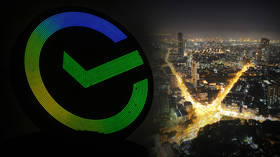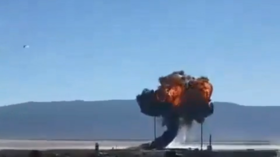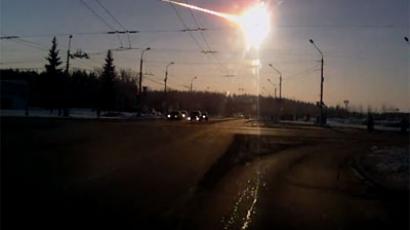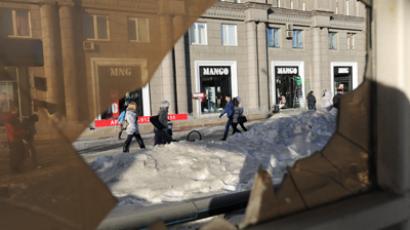Asteroid 9 times size of ocean liner approaches Earth
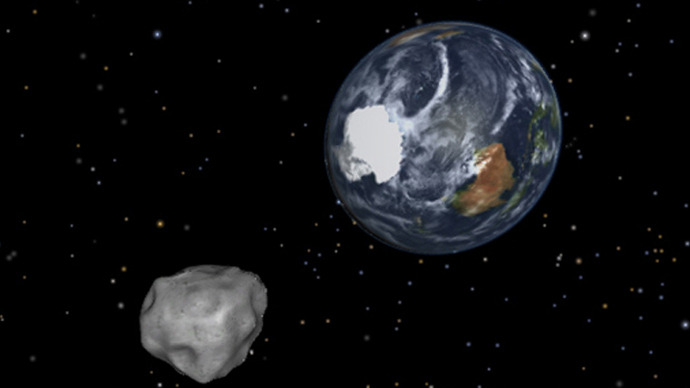
The 1998 QE2 asteroid has the physical mass to potentially deliver life on Earth a knockout punch, being 2.7km in length. It is to buzz our planet on May 31, aweing the stargazing community.
Officially known as Asteroid 1998 QE2, the ‘minor planet’, as
astronomers refer to these space objects, is about nine times the
length of its name-sharing ocean liner, Queen Elizabeth 2.
The incoming space object is not named in honor of Queen Elizabeth
II, however, nor the 12-deck QE2 luxury liner. It’s simply the
designation assigned by the US Minor Planet Center in Cambridge,
Massachusetts, based on an alphanumeric code for naming
newly-discovered asteroids.
Aside from the asteroid’s hulking mass, another thing that
intrigues astronomers about QE2 is that nobody can say with any
certainty where it came from.
One clue to its origins, however, is that its surface is said to be
covered with a sticky, black residue, suggesting that it may be the
remains of a comet that came in close proximity to the sun, Amy
Mainzer, a researcher at Jet Propulsion Laboratory at La Cañada
Flintridge, California, told the Los Angeles Times.

Another explanation is that QE2, discovered on August 19, 1998 by the Massachusetts Institute of Technology, was originally part of the asteroid belt between the orbits of Mars and Jupiter, she said.
QE2’s nearest approach happens on May 31 at 20:59 GMT, bringing the huge space rock to within 3.6 million miles (5.8 million km) of Earth – about 15 times the distance to the Moon. While this may seem a great distance, in astronomical terms it is a mere stone’s throw away.
Mainzer emphasized the significance of the asteroid, drawing parallels with a past celestial event that had devastating consequences for the entire planet.
"This is a really big asteroid, similar in size to the one that killed off the dinosaurs, and it's getting very close to us," she told the Times.
"Fortunately we've been tracking its orbit very carefully so we know with great certainty it won't hit us. We don't need to panic, but we do need to pay attention, she added.
Since the threat of a doomsday scenario seems unlikely, astronomers will be given an opportunity to study the physical characteristics of asteroids, as well as their history.
"Whenever an asteroid approaches this closely, it provides an important scientific opportunity to study it in detail to understand its size, shape, rotation, surface features, and what they can tell us about its origin,” radar astronomer Lance Benner, the principal investigator for the Goldstone radar observations from NASA's Jet Propulsion Laboratory in Pasadena, California, said in a statement.
Observers will take advantage of radar technology to measure the asteroid's distance and velocity to improve the calculation of its orbit and compute its motion farther into the future than we could otherwise, he added.
The next arrival of Asteroid 1998 QE2 following its near-miss on May 31 will not occur again for another two centuries.
Rocky history
For millions of years, Earth has been occasionally pounded by space
objects both large and small. Russia, due to its sprawling
landmass, has played an unwitting host to many of these celestial
bodies.
In 1908, a comet explosion over a largely uninhabited area of
Siberia flattened some 80 million trees. The so-called Tunguska
Event is recognized as the largest impact event on or near Earth in
recorded history: The explosion was about 1,000 times more powerful
than the atomic bomb dropped on Hiroshima, Japan.
More recently, on February 15 this year, a meteor exploded in the
sky over the Russian city of Chelyabinsk. The shock waves from the
explosion shattered windows and damaged buildings, injuring more
than 1,500 people, mostly from flying glass and other debris.
Following the Chelyabinsk meteorite, which is the largest known
space object to have entered Earth's atmosphere since the Tunguska
Event, NASA chief Charles Bolden gave advice on how to handle an
asteroid that was on a collision course with Earth “if it's coming
in three weeks”: Pray.
While NASA is tracking about 95 per cent of the largest objects flying near Earth, only about 10 per cent of an estimated 10,000 asteroids with a diameter of 50 meters (165 feet) or more have been identified.
Meanwhile, mankind continues the search for ways to counter future space objects deemed dangerous.
Just days after the Russian meteor struck, the European Space Agency (ESA) announced a joint mission between Europe and the US that aims to strike an asteroid with a spacecraft.
The Joint European/US Asteroid impact and Deflection Assessment mission (AIDA) is preparing to intercept the asteroid Didymos in 2022, when it is about 6.5 million miles (11 million km) from Earth.
Didymos, which poses no immediate threat to Earth, is actually a binary system, in which an 800-meter-wide asteroid and a smaller 150-meter space rock orbit each other.
The AIDA mission - designed to test the theory that governments can protect the planet from a space object on a collision course with the planet - will target the smaller asteroid with a rocket at about 14,000 mph (22,539 kph) in an effort to knock the object off course.



